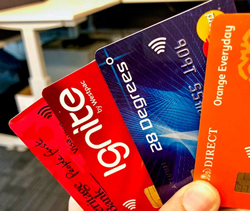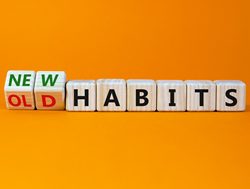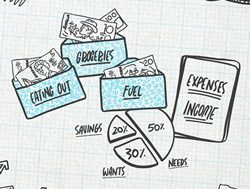Bryna Howes* shares advice on how to choose the right debt-busting methog for you.
 The weight of debt can be pretty heavy. And as such, it can be easier to bury your head in the snow instead of dealing with it.
The weight of debt can be pretty heavy. And as such, it can be easier to bury your head in the snow instead of dealing with it.
We avoid opening our mail for fear of the big red “overdue” stamp.
We panic.
We make foolish mistakes instead of just getting down to the business of sorting it out.
But fear no more!
We can’t wipe your debt slate clean with our purple chamois cloth, but we can discuss two well-known debt-busting methods in the interest of informing you of some of your options.
Behold: the snowball method vs.
the avalanche method.
Let the games begin!
What is the snowball method?
Debt is no joke, and as we mentioned in the intro, it can be intimidating to know how to figure out your debt problems.
If that sounds like you, the snowball method might be for you.
Step one: ranking each debt
With the snowball method, you basically create a list of all your debts.
Then, you rank them from largest to smallest.
Your list might look a little something like this:
Credit card #1: $6,000
Credit card #2: $4,800
Personal loan: $1,000
Now, while the list is intimidating, you’ve got a plan! Here’s what you do…
Step two: paying the minimum repayments, and focusing on the smallest debt first
First, you figure out the total amount of your income you can put towards your debts.
Consider setting aside as much money as possible, not just what it takes to pay the regular minimum amounts.
Then, figure out the regular minimum payment on each of your debts.
This is normally listed on your most recent account statement.
With these numbers in mind, you’ll now focus your sights on the smallest debt.
In the case of the example above, you’d focus on your personal loan of $1,000.
Then, you take the amount allocated to your total debt.
You ensure you’re meeting the regular minimum payment amounts on your other debts, and then you allocate all remaining money towards the debt you’re focusing on i.e. the smallest debt.
Step three: repaying the smallest debt, then focusing on the next smallest
Once you’ve paid off that debt, you start the process again by working on the next smallest debt.
Why this method can work
The idea behind this method utilises psychology.
What you’re doing here is looking for a “quick win”, a way to make yourself feel like you’re actually getting somewhere.
When you reach that first goal — you’ve paid off one whole debt! — hopefully you’ll feel a sense of achievement that’ll inspire you to reach for the stars and feel motivated to tackle your next debt.
Why it may not be right for you
Now, having said this, the snowball method has some disadvantages.
The most important issue to take note of is your other debts.
In the example above, the credit cards would continue to accumulate interest charges and fees, and sometimes a higher rate of interest.
This is something you should take into account when you’re considering the best debt-busting method for you.
What is the avalanche method?
Next in the ring is the avalanche method.
Step one: ranking each debt in order of interest rates
With the avalanche method, you again create a list of all your debts, and this time, you also write down their respective interest rates (if any).
Then, you rank them in order of the highest interest to the lowest interest rate.
Your list might look a little something like this:
Credit card #1: $3,000 w/ 20.74 per cent interest rate
Credit card #2: $4,800 w/ 13.74 per cent interest rate
Personal loan: $1,000 w/ 6 per cent interest rate
Now, with this method, things work a little differently.
Here’s what you do…
Step two: paying the minimum repayments, then focusing on the highest interest debt
Again, you figure out the total amount you can put towards your debts.
And again, you should set aside as much as possible, not just what it takes to pay the regular minimum amounts.
Then, again, figure out the regular minimum payment on each of your debts.
This is where things change.
With this method, you focus your sights on the debt with the highest interest rate.
In the case of the example above, you would focus on the credit card with the 20.74 per cent interest rate.
Then, you take the amount allocated to your total debt.
You ensure you meet the regular minimum payment amounts on your other debts, and then you allocate all remaining money towards the debt you’re focusing on i.e. the debt with the highest interest rate.
Step three: Once the highest interest debt gets repaid, the next highest debt gets the focus
Once you’ve paid off that debt, you start the process all over again by working on paying down the debt with the next highest interest rate (while paying minimums on the others).
Why this method can work
The idea behind using this method is it’s usually the most financially sound method.
This is because, in most cases, you’ll save the most money.
Basically, you’ll be putting most of your money towards paying down the principal you owe, rather than interest, using this method.
Why it may not be right for you
You need to be consistent in making your repayments – and not just minimum repayments – if you want to take full advantage of this strategy.
Should you choose the snowball or avalanche method to repay your debt?
So, now you have the gist of each method, which one should you choose?
Ultimately, you have to choose the method that makes the most sense for you and your personal situation.
It might be worth speaking to a finance professional — and if you’re in real strife, you may even need to talk to a financial counselling service.
But before we go, here’s something worth mentioning: A study undertaken by the Kellogg School of Management in 2012 showed that people with large balances are “more likely to stick with their debt payoff plan if they focus on smaller balances first.”
Weigh up the numbers and your motivation levels and make a decision that works for you.
Whichever way you go, just get started.
That’s the true first step.
*Bryna Howes is the VP of Marketing & Brand at Spaceship.
This article first appeared at spaceship.com










